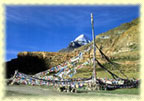|
The Sacred Mount Kailash
The sacred Mount Kailash plays an important role in Bon, Buddhism, Jainism and Hinduism. Each of these religions have their own belief about it and see the mountain as an embodiment of their gods. It is certain, therefore, that the sacredness of Mount Kailash originated in its religious significance and the majority of the followers of these religions live in India and Asia.
According to the indigenous Tibetan Swastika Bon religion, Mount Kailash and Manasarovar are the holy lands, which are consecrated by its founder Thonpa Shenrab Miwo and where he lived, taught and disseminated the religion. Shenrab Miwo predicted that there would be established nine orders of Bon schools near Mount Kailash and Manasarovar. Ever since, Bon believers have considered Mount Kailash and Manasarovar to be the foundation of their religion. The prehistoric Bon is believed to have flourished all over the country during the period of the Shang Shung kingdom of Tibet. Eventually, Bon practitioners established monasteries and retreat centers, so the teachings of Thonpa Shenrab Miwo have been transmitted down through the Bon lineage.
Buddhists have several stories of how Mount Kailash came to be the most sacred mountain on the earth. In 5th century, the historical Buddha Shakyamuni and five hundred Arhats miraculously traveled there to stop the cannibal demon Ravan taking away Mount Kailash. Today, there are four footprints of the Buddha in each direction around Mount Kailash and a rope's mark behind Mount Kailash left by Ravan trying to remove it magically. Secondly, according to the Buddhist cosmology, Mount Kailash as the mythical image of the King of Mountains at the centre of the universe known as "Mt Meru". However, more popularly, Mount Kailash is seen as the sacred fortress of the most wrathful tantric deity Chakrasamvara (Tib. Palkhorlo Dompa), the deity with four with faces and twelve hands. Tantric practitioners of Buddhism believe Buddha Shakyamuni manifested in the form of Chakrasamvara in order to benefit of all beings. Chakrasamvara is considered the source of the highest tantra. Another term for Chakrasamvara is Heruka. The three syllables of Heruka mean: "He" means the nature of emptiness of dharma or phenomena, "Ru" means the nature of emptiness of beings. "Ka" means the union of bliss and emptiness. Realizing the nature of emptiness of phenomena and beings is known as the mind of great bliss. "Chakra" means wheal and "Samvara" means the supreme bliss. It is also translated as "the spontaneous great bliss". By practicing Chakrasamvara tantra, Buddhists try to gain the profound realization of the emptiness of all phenomena and being. This is described as the supreme bliss of mind. The sexual union of Chakrasamvara and his consort Vajrayogini (Tib. Dorjee Pegmo) symbolizes the ultimate wisdom and compassion to achieve the state of enlightenment for the benefit of all sentient beings. Mount Kailash is also the retreat centre of Kagyupa Order started by the great Tibetan yogi Milarepa.
In Hinduism, Lord Shiva is the creator of the universe and Mount Kailash is his throne. Shiva, Brahma and Vishnu were the three principle gods. A Hindu legend says that they stirred the vast ocean creating the sun, moon, stars and earth. As they continued stirring, they found various precious objects and a pot filled with poison. The great god Shiva knew that the earth would be destroyed if he placed the poisonous pot on the ground. He found nowhere else to get rid of it. So, the god Vishnu swallowed the pot, intending to store it somewhere in his body. Unfortunately, he became unconscious. Then, Shiva took the pot from Vishnu and kept it in his own throat. The poison not only made his neck turn blue but also caused him to experience immeasurable pain. To avoid the suffering, Shiva was desperate to find a cool land. Therefore, he chose to travel to Mount Kailash, because it was the coldest and the highest on the earth. In the Hindu creation story, snakes are water element and the moon is cool, so he placed a snake around his neck and the moon at the side of his head. Jainism is one of the ancient Indian religions
founded around the sixth century B.C. It is also known as the Naked
religion because it's founders, including Lord Rishabha used to
practice without wearing any cloths. This practice was a part of
their enduring hardship and for achieving spiritual realization.
Jainists believe in cause and effect like Buddhism but they do not
follow the middle doctrine of Buddha. Jainism practices two main
paths. Engaging in ascetic practices to correct past negative actions
or karma. Abiding by disciplines that do not create more causes
to be reborn in this world. Jainist believe Lord Rishabha traveled
to Mount Kailash to engage in his spiritual practices. He is believed
to have gained liberation in front of Mount Kailash, where a rocky
mountain is called, Throne of Buddha. In Hindi language, the rocky
mountain is called Atri Pelda. "Atri" means eight and
"Pelda" means sacred land. The rocky mountain has eight
levels. The Jainists know Mount Kailash as Astapada. |
|
||||||||||||||||||||||||||||||||||||||||||||||||||||||||










